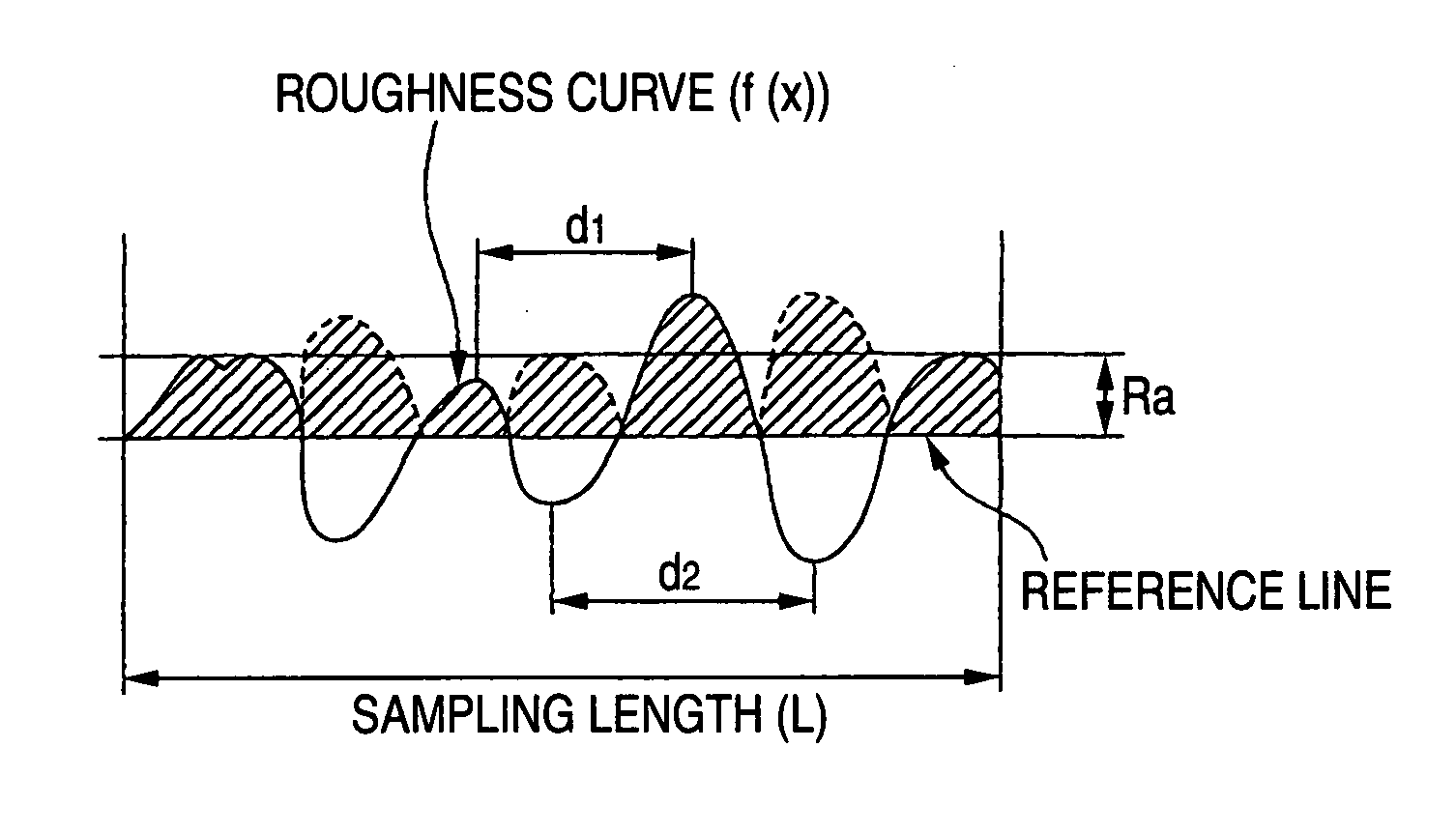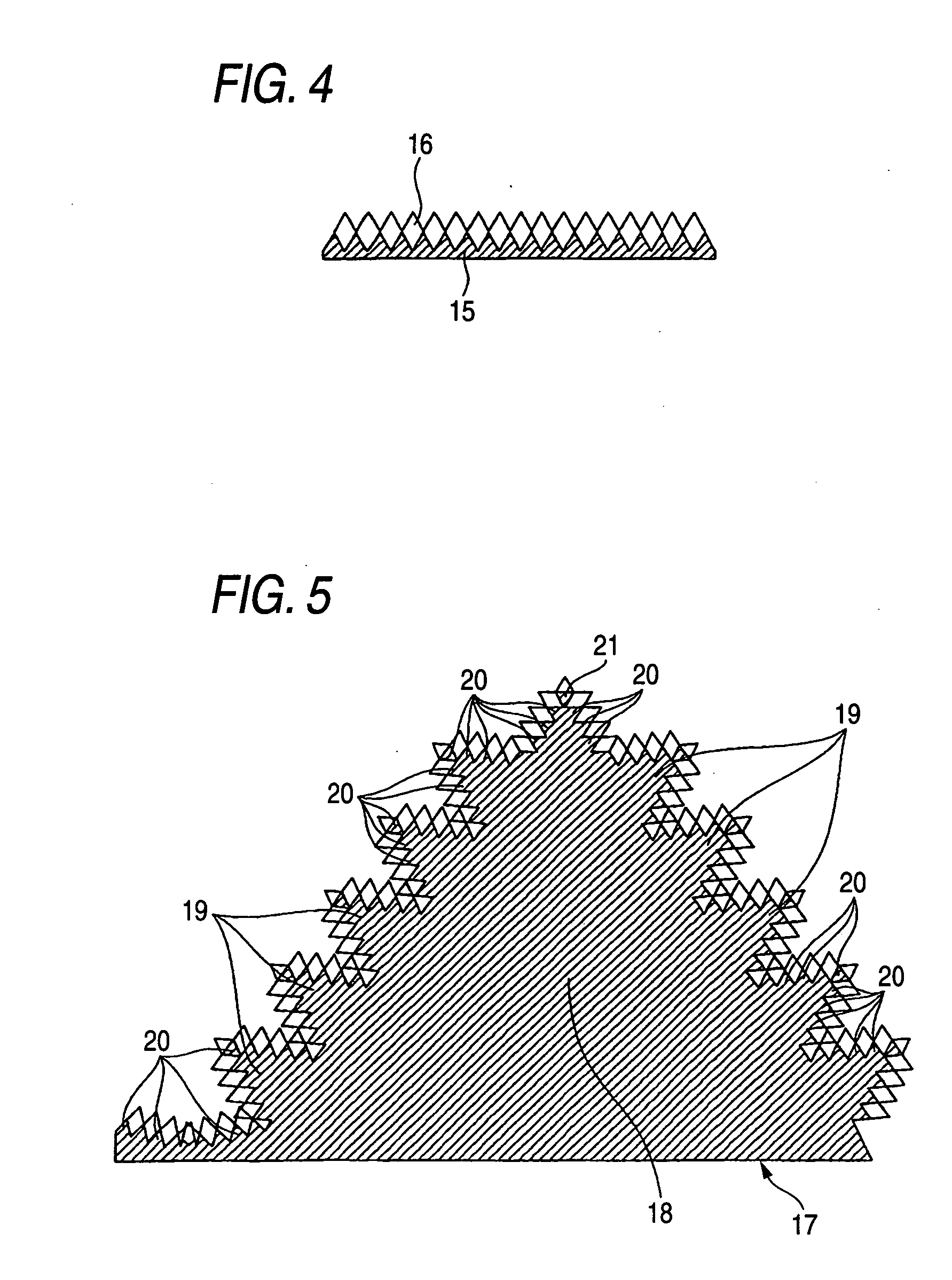Electrode for electrolysis and process for producing the same
- Summary
- Abstract
- Description
- Claims
- Application Information
AI Technical Summary
Benefits of technology
Problems solved by technology
Method used
Image
Examples
example 1
[0102] A niobium metal plate having a size of 30 mm×30 mm and a thickness of 2 mm (substrate sample) was blasted by blowing #60 alumina particles against both sides of the plate using 0.7 MPa compressed air.
[0103] Subsequently, the substrate sample was immersed for 10 minutes in a 60° C. aqueous solution having H2O2 (hydrogen peroxide) of 2 wt % and HF (hydrofluoric acid) of 5 wt %, thereafter subjected to ultrasonic cleaning in pure water at 28 kHz and 300 W for 15 minutes, and then dried. An examination with a laser microscope for surface shape revealed that this substrate sample had an Ra of 3.7 μm and an RSm of 34 μm, which correspond to medium tops / valleys.
[0104] A 3-D image obtained from a laser microscope photograph (1,000 magnifications) of a surface of this conductive substrate is shown in the upper part of FIG. 6, and a profile of that width-direction section of this 3-D image which extends along the depth-direction center is shown in the lower part of FIG. 6.
[0105] A s...
example 2
[0111] A tantalum metal plate having a size of 30 mm×30 mm and a thickness of 2 mm (substrate sample) was blasted by blowing #36 alumina particles against both sides of the plate using 0.5 MPa compressed air. Subsequently, the substrate sample was immersed for 20 minutes in a 60° C. aqueous solution having H2O2 (hydrogen peroxide) of 2 wt % and HF (hydrofluoric acid) of 5 wt %, thereafter subjected to ultrasonic cleaning in pure water at 28 kHz and 300 W for 15 minutes, and then dried. The substrate surface had a shape having an Ra of 11.8 μm and an RSm of 50 μm, which correspond to medium tops / valleys.
[0112] Subsequently, a seeding treatment and diamond layer formation were conducted in the same manners as in Example 1.
[0113] It was ascertained through Raman spectroscopy that a diamond layer had deposited on the substrate. From an electron photomnicrograph of a section, the thickness of the diamond layer was found to be 5 μm. The diamond layer was examined with a laser microscope...
example 3
[0121] Three niobium metal plates having a size of 30 mm×30 mm and a thickness of 2 mm (substrate samples) were blasted by blowing #60 alumina particles against both sides thereof using 0.7 MPa compressed air. Subsequently, the niobium plates were subjected to ultrasonic cleaning in pure water at 28 kHz and 300 W for 15 minutes and then dried. Immediately thereafter, the niobium plates were introduced into a vacuum furnace and heated at a rate of 4° C. / min while maintaining a vacuum of 10-3-10-5 Pa. Thereafter, the first niobium plate was heated to 750° C., held at this temperature for 10 hours, and then allowed to cool to room temperature in the furnace at a rate of 4° C. / min. The second niobium plate was heated to 1,090° C., held at this temperature for 1 hour, and then allowed to cool to room temperature in the furnace at a rate of 4° C. / min. The third niobium plate was heated to 1,090° C., held at this temperature for 1 hour, subsequently further heated to 1,300° C., held at thi...
PUM
| Property | Measurement | Unit |
|---|---|---|
| Length | aaaaa | aaaaa |
| Length | aaaaa | aaaaa |
| Length | aaaaa | aaaaa |
Abstract
Description
Claims
Application Information
 Login to View More
Login to View More - R&D
- Intellectual Property
- Life Sciences
- Materials
- Tech Scout
- Unparalleled Data Quality
- Higher Quality Content
- 60% Fewer Hallucinations
Browse by: Latest US Patents, China's latest patents, Technical Efficacy Thesaurus, Application Domain, Technology Topic, Popular Technical Reports.
© 2025 PatSnap. All rights reserved.Legal|Privacy policy|Modern Slavery Act Transparency Statement|Sitemap|About US| Contact US: help@patsnap.com



